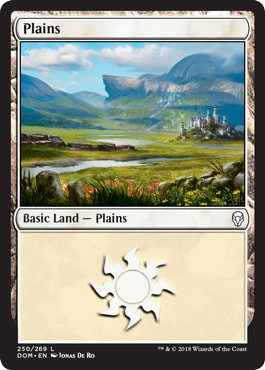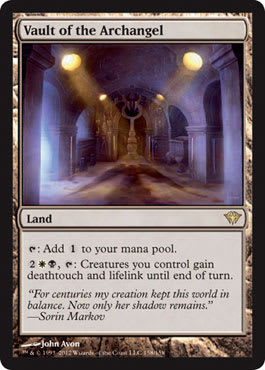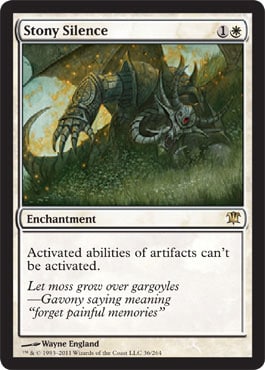Last week, I used a budget of $100 to put together a Humans/tokens deck for Standard. Since writing that article, I played the deck in a sixty-eight-person 1K even. In addition to gaining a better understanding of the deck and an even greater respect for it, I split in the Top 4 and took home $200. Based on what I’ve learned, I’ve made some minor changes to the deck, and I’ve become convinced that in addition to being inexpensive, it’s among the best decks in the current environment.
This is the deck I ended up with and then played in the tournament:
"Humans/Tokens"
- Creatures (13)
- 4 Champion of the Parish
- 4 Doomed Traveler
- 4 Elite Vanguard
- 1 Mikaeus, The Lunarch
- Spells (24)
- 4 Midnight Haunting
- 4 Gather the Townsfolk
- 4 Lingering Souls
- 4 Honor of the Pure
- 4 Intangible Virtue
- 4 Oblivion Ring
- Lands (23)
- 17 Plains
- 2 Swamp
- 4 Isolated Chapel
- Sideboard (15)
- 4 Revoke Existence
- 4 Shrine of Loyal Legions
- 4 Loyal Cathar
- 2 Timely Reinforcements
- 1 Mortarpod
The event I played in was seven rounds with a cut to Top 8. I went 5–1 before intentionally drawing in the last round. I won my quarterfinal match, and then I agreed to a four-way split (under the head judge’s watchful eye) that earned me the equivalent of second prize ($200) and an invite to the TCG championship event that this event was a qualifier for. In addition to winning a cool prize, this event also helped me learn several useful things about the deck:
W/U Delver Is an Excellent Matchup
This wasn’t immediately obvious. As a matter of fact, the first Delver deck I faced gave me my one and only loss. As I faced two more W/U Delver decks (being run by solid players) and defeated them pretty handily, the matchup came into better focus. Basically, those decks usually can’t win without a Sword of War and Peace, although sometimes a Pike equipped to an Invisible Stalker will do the job. Even the Sword sometimes isn’t enough. Except for Invisible Stalker, their creatures can’t make it through my wall of tokens without the help of a Sword.
Their primary creature removal is Vapor Snag, and it’s not very good against 1-drops and cards that put multiple tokens into play. The match I lost went to three games, and both of the games I lost were close affairs. In both games, my hand was jammed full of spells because I was mana stalled, and he was able to play and equip a Sword for 5 mana and kill me in one swing. Each time, I had non-instant-speed answers to the Sword in my hand. One of the games, I was even at 14, and he killed me in one swing!
My Plan against Mass Removal Is Solid
In the quarterfinals, I played against a W/B control deck that included Day of Judgment and Black Sun's Zenith. In the past, a deck with this much mass removal has often given me the most trouble. By sideboarding in four Loyal Cathars and four Shrine of Loyal Legions, I was able to overcome the card advantage he was gaining with mass removal.
Lands Are Good
Surprisingly, land-heavy opening hands were much better than mana-tight ones. I won the games in which I kept with five lands, and I frequently lost the games in which I started with only two lands in my opening hand.
My curve is low and very flat: twelve spells at 1 mana, twelve spells at 2 mana, and twelve spells at 3 mana, with the Lunarch able to fit where it is needed. In order for the deck to have a really explosive draw, it needs to make it to 4 mana quickly so I have the option of playing two spells in one turn—whether it’s a 3 and a 1 or a pair of 2-mana spells. This is especially true because of the deck’s low number of instants. It’s hard for me to play around permission without being able to play two things in the same turn. Almost every game I lost involved me stalling at fewer than four lands for several turns.
Having 5 mana is also exciting because not only does it increase my options for playing two spells in one turn, but I can play and flash back a Lingering Souls in the same turn.
The Deck Has Painfully Few Instants
Out of thirty-seven spells in the main deck, only the four Midnight Hauntings can be cast on my opponent’s turn. Besides helping me play around permission, I like the ability to wait and see whether my opponent plays some mass removal—before adding more creatures to the board right before I untap. This is one of the great things about Shrine of Loyal Legions. I can leave 3 mana open and wait for my opponent to finish his main phase before I put more troops into play.
My sideboard doesn’t have any instants. The biggest problem may be my lack of instant answers to Sword of War and Peace. Between four Oblivion Rings and four Revoke Existence, I have a large quantity of answers, but none of them save me from one, big hit.
When in Doubt, Sideboard out Elite Vanguards
I usually try to win Game 1 with fast pressure and tempo before my opponent has a chance to do anything too ridiculous. A 2/1 for 1 mana that also synergizes with Honor of the Pure and Champion of the Parish goes well with this approach.
After sideboarding, the game usually becomes more about card advantage and less about tempo. I still want to keep the ability to make a play on turn one, but Vanguards are the weakest link. Doomed Traveler is good against removal, and Champion of the Parish can quickly become resistant to cards like Tragic Slip, Gut Shot, and Curse of Death's Hold. The Vanguard dies to anything and often just dies with some friends to a mass-removal spell.
Since the event, I’ve made some minor changes to the deck. The only change I’ve made to the maindeck is the addition of a Vault of the Archangel. I had an earlier version of the deck that had two Vaults, and I kept having opening hands with some combination of Swamps, Chapels, and Vaults that prevented me from playing a 1-drop, but they otherwise seemed wrong to mulligan.
In addition, due to my twelve 1-drops and frequently sideboarding in four Loyal Cathar, I really like being able to have ![]()
![]() on turn two. In an effort to help support the two Vaults, I was also running a third Swamp, further hurting the playability of my opening hands. Since then, I switched to a version with sixteen Plains, four Chapels, and two Swamps. I found the version with twenty-two lands to have enough white mana, but not enough total mana—I too frequently stalled at three lands.
on turn two. In an effort to help support the two Vaults, I was also running a third Swamp, further hurting the playability of my opening hands. Since then, I switched to a version with sixteen Plains, four Chapels, and two Swamps. I found the version with twenty-two lands to have enough white mana, but not enough total mana—I too frequently stalled at three lands.
The change to twenty-three lands definitely felt much better when I played it in the 1K. The addition of another Plains specifically probably wasn’t strictly necessary, so I’m changing it to a single Vault. With six sources of
The main reason I want a Vault in the deck is to help with a sudden rise in popularity of the mirror match. An increasing number of these decks have been showing up in online events, and I’ve decided I need to address the matchup more. The mirror match is usually about who draws more Honors and Virtues, but a Vault can overcome this. If my creatures have deathtouch, they can trade with my opponent’s creatures that are bigger due to more enchantments. The lifelink can also help me outrace the mirror. The lifelink feature of the Vault also gives me another way to beat a Sword of War and Peace in the maindeck.
The other change I’ve made is to the sideboard. I’ve added three Divine Offerings to the sideboard. Now it looks like this:
"Humans/Tokens Sideboard Update"
- Sideboard (15)
- 3 Divine Offering
- 2 Revoke Existence
- 2 Timely Reinforcements
- 4 Shrine of Loyal Legions
- 4 Loyal Cathar
I hope this will seal up the matchup against the most popular deck in the format: W/U Delver. The ability to get rid of an Equipment at instant speed—and even gain a few life in the process—is probably too big of a swing for a Delver deck to overcome in this matchup. I kept a couple of the Revoke Existences, in part because of the ability to get rid of cards such as Honor of the Pure and Oblivion Ring and in part to exile cards such as Wurmcoil Engine and Solemn Simulacrum, both of which I did in the 1K.
For many people, the right option is to play with Stony Silence in the sideboard. It’s amazing against Ratchet Bomb, a card that is seeing a lot of play in Standard right now and that’s really good against this deck. It can also be good for preventing creatures from being equipped. As a powerful silver bullet for a particular common problem, Ratchet Bomb, this card does make a lot of sense as a one- or two-of in your sideboard. I’m currently choosing not to run them for three reasons, mostly tied to the fact that it’s not my style of card:
- It’s proactively reactive. It’s a card I need to playbefore I need it. In addition, it does nothing in the meantime. So, I have to choose to spend 2 mana and a card early in the game to do nothing—instead of applying more pressure—in case I might need it.
- It’s very narrow. One of the reasons I’ve been running Revoke Existence instead of Divine Offering is for its additional abilities to exile and to deal with enchantments. Only my conviction that I need to be able to remove artifacts at instant speed convinced me to add them. Stony Silence is even more narrow than Divine Offering. It’s useless against an Equipment that is already equipped or against most artifact creatures, for example.
- Cards such as Loyal Cathar and Shrine of Loyal Legions are already helping me deal with mass removal like Ratchet Bomb. The Shrines can reload the board after a Bomb, or if my opponent is waiting to use it on my Shrine’s tokens, I have a chance to get rid of the Bomb with a card such as Oblivion Ring, Divine Offering, or Revoke Existence.
If it is your type of card, however, go ahead and put a couple of them into your sideboard. Of course, this deck started out with a budget of $100. The total estimated cost of my previous version was $96.65. We’re still good. The one Vault only adds $3 to my total, and the Divine Offerings don’t cost more than the cards they replace. I actually bought some this week for twenty-five cents each.
It’s also been pointed out that most people can find basic lands for less than ten cents each, and in general, people should be able to beat many of the estimated prices from my last article. I hope you find this to be true. One of my favorite things about this experience has been finding out that spending more money doesn’t always mean making a better deck.
Even if I’m not using my full budget cap, it doesn’t mean I’m not playing a good enough deck or a good enough version of the deck. I do think this a good example of a budget deck in that it’s among the cheapest decks in the format by far. However, I also think it’s among the best decks in the format—if you gave me an unlimited budget to build the deck, I doubt I would make any changes. Sure, it might be reasonable for me to add Hero of Bladehold, Sorin, or Sword of War and Peace, but I’m quite happy with it the way it is. I’ll save my $200 for building decks after Avacyn Restored comes out.




























